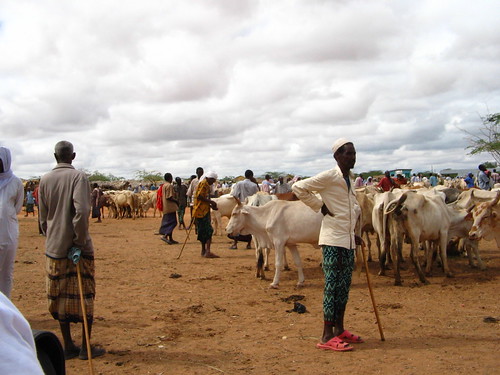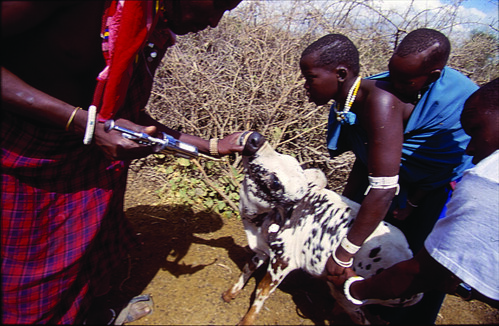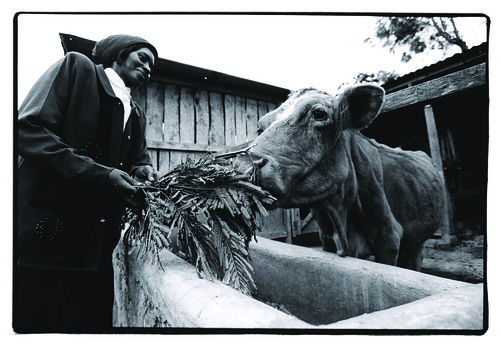Orma Boran cattle crossing a river in Kenya. Cattle and people both can be infected with Rift Valley fever (Photo credit: R Dolan)
Livestock researchers say the traditional knowledge of local pastoralists in East Africa needs to be included in programs to better control livestock diseases in the region.
Somali and Maasai herder early warning systems both were key in identifying the risk factors and symptoms of Rift Valley fever in an outbreak in 2006/7.
Rift Valley fever is an acute viral zoonosis spread by mosquitoes. It primarily affects domestic livestock such as cattle, camels, sheep and goats, but can also infect, and kill, people, especially those handling infected animals.
First isolated in humans in the Rift Valley region of Kenya in 1930, until the 1970s Rift Valley fever was reported mainly in southern and eastern Africa, primarily Kenya, where it was considered an animal disease, despite sporadic human cases. But after the 1970s, explosive outbreaks occurred in human populations throughout Africa, Indian Ocean states and the Arabian Peninsula. Epidemics in Egypt in 1977/8 and in Kenya in 1997/8 each killed several hundred people. Another outbreak in Kenya in 2006/7 killed more than 100 people.
In East Africa, Rift Valley fever outbreaks have coincided with heavy rainfall and local flooding, which can lead to expansion of mosquito populations. In an assessment made to review lessons from the 2006/7 outbreak in East Africa carried out by scientists from the International Livestock Research Institute (ILRI) and the Kenyan and Tanzanian departments of veterinary services, researchers found that Somali pastoralists of northeastern Kenya accurately assessed the likelihood of an outbreak based on their assessments of key risk factors, and they did so long before veterinary and public health interventions began. The study also looked at the experiences of Maasai herders of northern Tanzania, who accurately recognized symptoms such as high abortion rates as indicating the presence of the infection in their herds.
Among the environmental factors the Somali communities noticed as likely to lead to an outbreak is an increase in rainfall (usually accompanied by floods) and an increase in mosquitoes. Both preceded the 2006/7 outbreak and had been present in the last outbreak of Rift Valley fever in the region in 1997/8. The Somalis also accurately associated a ‘bloody nose’, or Sandik, in their animals with Rift Valley fever.
The role of this traditional knowledge in predicting Rift Valley fever is the subject of a paper, ‘Epidemiological assessment of the Rift Valley fever outbreak in Kenya and Tanzania in 2006 and 2007’, published in the August 2010 supplement of the American Journal of Tropical Medicine and Hygiene.
The authors say that Somali pastoralists are particularly able to predict not only the symptoms of Rift Valley fever in their animals but also the likelihood of an outbreak of the disease. Indeed, observations by local communities in risk-prone areas were often more timely and definitive than the global early warning systems in use at the time of the 2006/7 outbreak.
‘Timely outbreak response requires effective early warning and surveillance systems. This study points out the important role that livestock keepers can play in veterinary surveillance,’ the authors say.
As a result of the experiences of the 2007 outbreak, the authors recommend adopting new forecasting models and surveillance systems ‘that place more emphasis on climatic information [to] increase the lead time before events and enhance the ability of decision-makers to take timely action.’
The researchers also say that outbreaks of Rift Valley fever could be managed better if disease control workers were able to run models that combined economic with epidemiologic factors. With such models, they could better determine the benefits of implementing various disease surveillance and control methods, and the best times to implement each method selected for each circumstance.
This piece is adapted from the article New journal article: An assessment of the regional and national socio-economic impacts of the 2007 Rift Valley fever outbreak in Kenya by Tezira Lore, communications specialist for ILRI’s Markets Theme.
To read the complete report and its recommendations please visit http://www.ajtmh.org/cgi/content/abstract/83/2_Suppl/65/
A related ILRI news article addresses the full effects of the 2006/7 Rift Valley fever outbreak in East Africa, including the national and regional socioeconomic impacts of the outbreak and its effects on human and animal health.




